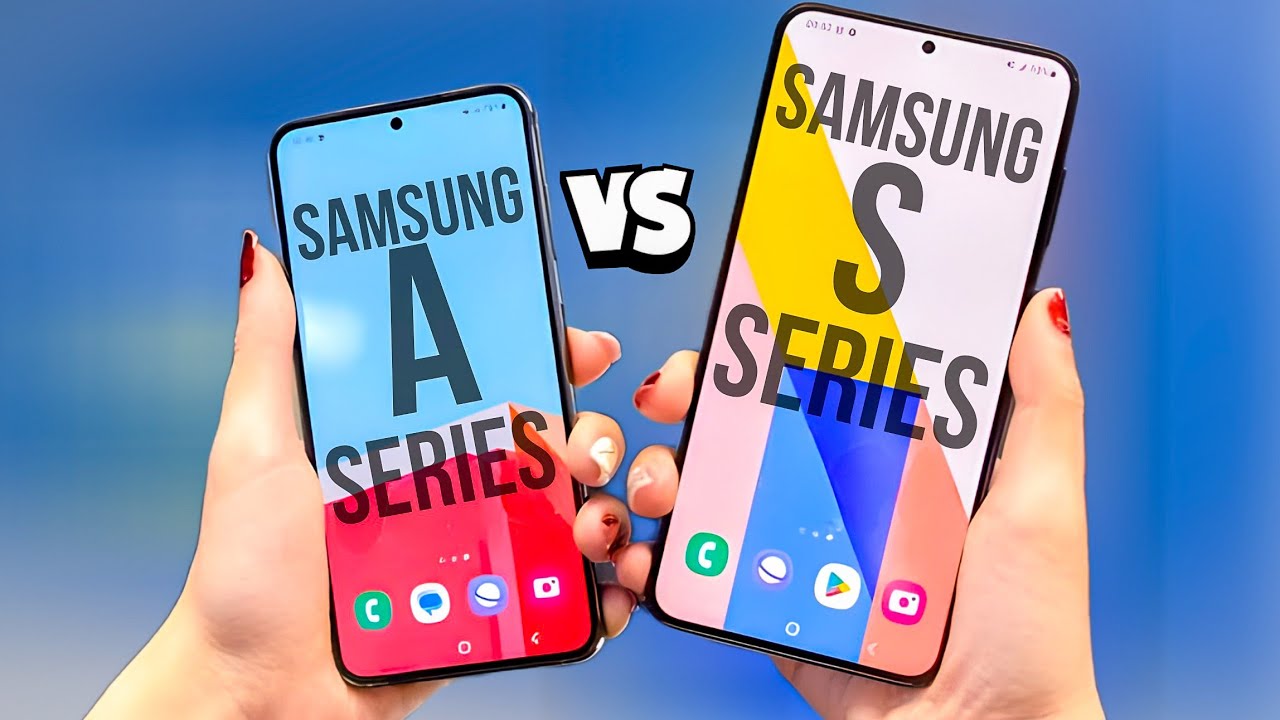
a vs s series
Which Samsung Series has better features, A vs S series by Techworld0?
Table of Contents
Samsung A vs S Series — Which One to Opt For?
Samsung is the most popular smartphone brand as of this writing in January of 2025 with many products on the market. Of all the existing model families, the Samsung A Series and S Series are among the most popular choices for consumers. Although both series are packed with great features, the two are aimed at distinct segments of the market. In this article, we will discuss the main differences that exist between Samsung A Series and S Series in terms of performance, design, camera, battery life, software experience, and pricing. We will also address some frequently asked questions to help you get an informed decision.
A Look into Samsung A Series And S Series
Samsung A Series
The Samsung A Series is the consumer’s choice for budget-friendly phones that don’t compromise on quality. This is usually what you get for a decent price in terms of features and performance. With the A Series, which includes the Galaxy A14, A34, and A54, these all serve to help consumers that need specific capabilities while being budget-friendly.
Samsung S Series
The Samsung S Series is the flagship line of Samsung smartphones, however. The S Series is known for premium build quality, advanced technology, and high-end specifications, catering to power users who demand top-of-the-line performance and features. The Galaxy S24 / S24 Ultra models represent all of Samsung’s greatest advancements in design, camera technology, and processing capabilities.
Differences Between Samsung A Series and S Series
Performance
However, for the Samsung A vs S Series comparison, performance does become a big difference.
A Series Performance
A Series usually come with processors like the Exynos 1380 or Snapdragon 778G, and should be enough for everyday tasks such as browsing, social media, and basic gaming. These devices are ideal for users who do not need high-performance features but still want a smooth experience for the tasks of daily life.
For instance, the Galaxy A54 comes with an Exynos 1380 processor with up to 8 gigs of RAM. This setup is highly efficient in allowing the user to run several apps at once without much of a latency. It is good enough for video streaming, social media browsing, and productivity apps.
S Series Performance
In comparison, the S Series gets top-of-the-line processors like Snapdragon 8 Gen 2 or Exynos 2200. This means superb performance for resource-intensive tasks like gaming, video editing, and multitasking. The S Series is for those who require a device that can keep up with intense workloads, without stuttering.
E.g., the Galaxy S24 Ultra sports up to 12GB of RAM in addition to the powerful processor. This setup guarantees even the most resource-intensive apps gets handled smoothly, while letting users switch between apps without hitch.
Camera Capabilities
When it comes to the camera, the two series had very different fates.
A Series Camera Quality
The Samsung A Series features an acceptable camera setup perfect for casual photography. The Galaxy A54, for example, has a primary sensor of around 64MP, which can take decent images in good lighting conditions but pretty average images in low-light ones. The secondary shooters are usually an ultra-wide and a depth sensor to enhance the versatility of the images.
These cameras can produce acceptable output for casual use — think Instagramming home-cooked meals and family photos — but they often don’t measure up in detail or functionality to higher-end models.
S Series Camera Quality
Conversely, S Series is best when it comes to photography with multiple lenses and higher megabytes offered in this series. The Galaxy S24 Ultra, for instance, is expected to sport a quad-camera array with a 200MP primary sensor, providing better flexibility in shooting options and amounts of detail. The extra lenses typically feature ultra-wide and telephoto ranges with optical zoom.
Each of the S Series also have advanced software features like improved night mode photography, AI scene recognition, and improved video recording capabilities (8k). In this way, it is perfect for photographers who want high-quality images in a wide range of scenarios.
Design and Build Quality
These two series also differ in design and build quality a fair bit.
A Series Design
Samsung A Series devices tend to use plastic materials to help reduce costs which translates to a relatively light device that does give up some premium feel to their S Series family. This makes the A Series more drop-resistant (thanks to the lighter build) but lacks the premium feel that you would expect with more expensive smartphones.
For instance, the Galaxy A34 sports a plastic back with a glossy finish that picks up fingerprints easily and makes it look dirty from up close but relatively pleasant from a distance. The design looks its part, but lacks the premium quality seen on flagship models.
S Series Design
The S Series, in contrast, features glass- and metal-built premium designs. These gadgets are not just beautiful but also comes with features such as IP68 water and dust resistance. Also, the S Series will have thinner bezels for better immersion whereas the A Series often include thicker bezels.
For example, the Galaxy S24 Ultra has an aluminum frame and Gorilla Glass Victus front and back. This adds to the durability as well as adds a premium feel that will appeal to the consumers who will spend for a premium device.
Display Quality
While AMOLED displays are standard across both series, there are differences in quality.
A Series Display
As for the A Series, they provide decent resolution for regular use as well vibrant colors. The majority of these models feature Full HD+ resolution (1080 x 2400 pixels) that offer sharp vistas for streaming films or browsing the internet.
But, it still has lower peak brightness levels than the S Series displays. For instance, where an A series will just be beating 800 nits, under direct sunlight it won’t be as easily visible as a flagship.
S Series Display
The S Series provides high resolutions (up to 3200 x 1440 pixels) and faster refresh rates (up to 120Hz), allowing for smoother animations and better responsiveness when playing games or scrolling through content. They are also probably the best possible option for a customer looking for a smartphone with good display quality.
Take for example the Galaxy S24 Ultra, its display is capable of an adaptive refresh rate, going from 1Hz all the way up to 120Hz depending on the usage scenario, which ensures smooth scrolling while saving on power consumption with no need for such high refresh rates.
Battery Life
When comparing these two series, battery life is often an important element for consumers.
A Series Battery Life
Samsung A Series devices usually have bigger batteries (more than 5000 mAh in many cases) that can easily last a day with normal usage. Support for fast charging allows it to be refuelled quickly when so desired — typically about 25W — which is enough for most users.
For instance, moderate use including browsing social media or video streaming results in battery life that lasts all day, with users not having to be concerned with their device running out of power before the evening.
S Series Battery Life
However, it also features wireless charging and reverse wireless charging capabilities similar to those of the Galaxy S Series. This enables the users to set up their phone as a power bank and charge other devices, a feature that is rare in the A series.
Galaxy S24 Ultra and other models usually have 5000 mAh benefit but also provide you much faster charging features (up to 45W wired charging) so that you can recharge your device quickly when time is at a premium.
Software Experience
These two devices have a very different software experience.
A Series Software Experience
Samsung A series:One UI (Android 13 and higher only for some models) This means that each and every part of One UI is easy to use and customizable enough to make it powerful, but not so much that people feel lost or overpowered by its complexity.
It does get security patches and certain feature updates over the years, but major Android version updates could be limited as compared to flagship variants because of hardware limitations.
S Series Software Experience
On the other hand, the Samsung S series uses One UI as well, but receives updates more often due to its flagship status in Samsung’s portfolio. Software updates are also taken seriously by Google with promises for timely updates (not just security patches but also major Android version upgrades) over multiple years, keeping the hardware relevant for a long time.
And flagship devices typically also include special software that leverages their higher-end hardware configs like advanced multi-tasking capabilities or better camera software.
Pricing
The pricing is one of the major differences between the two series.
A Series Pricing
Samsung A series smartphones are budget-friendly; starting from around the $250 mark often going up to around $500 depending on the design and features, so it is ideal for good, reliable phones that can be fairly cheap for consumers.
For example:
The Galaxy A14 will cost around $250.
The Galaxy A54 could be around $400 depending on which storage options are made available at retail locations.
By utilising this pricing strategy, Samsung catered to a huge audience looking for an affordable, yet powerful smartphone for day to day usage.
S Series Pricing
On the other hand, an S lineup is of a certain standard and will always come at a premium, as this is the flagship model of Samsung; so, normally with a base storage starting from $800 going into hundreds of dollars more for some massive storage options or unique abilities such as folding (Galaxy Z Fold for example).
For instance:
The Galaxy S24 begins at around $800.
Depending on the storage option chosen by consumers during the purchase decision in stores and on the web, the price of the Galaxy S24 Ultra can go beyond $1,200.
A flagship device that costs as much as an entry-level car makes the stakes high; it’s no longer about purchasing these devices, but investing in them — a gamble for consumers who want more out of their technology escape and a pricepoint that can only be unlocked by top-tier offerings from Samsung Electronics Inc.’s smartphone lineup.
Final Thoughts: What Should You Pick?
So to cut a long story short: Samsung A vs S Series is a choice between your needs and budget:
If you want a budget smartphone that fulfills basic tasks efficiently, packs decent performance, and satisfactory camera capabilities—the A series is just for you!
But if you’re looking for the best performance that comes with premium camera power and luxury looking materials, then the S series may be a more worth investment for those out there seeking a higher spec’d phone alongside premium specs to last longer than average time spent running through apps available from Google play store or other alternatives found connected over internet plans provided by their carrier around world today!
Each lineup caters handsomely towards versatile use cases wherein certain titles resonate better for prospects who already own other devices from within this range like zkG or Galaxy Tab + more yet others may find themselves investing into respective devices this time instead!
FAQ’S About Samsung A vs S Series
What is the difference between Samsung A series and S series?
The only difference is in their targeted audience:
A series — budget, with mid range specs fit for daily usage
The S series features cutting-edge features and high-end performance, targeting power users who need top-of-the-line capabilities from their smartphones!
Which series offers better camera quality?
Generally speaking:
In terms of photography, the S range generally features top-of-the-line camera systems with high-quality lenses that allow users to shoot excellent photographs, even in challenging lighting situations as compared to the relatively simpler systems used on many of its A-series sibling models!
Both series are water-resistant, right?
Only select models from:
The S series comes with IP68 water resistance ratings while most models in
S5, S6, S7: The A Series — These do not have that, hence they are not as durable for a longer period of time if exposed to moisture!
Which series has better display quality?
Typically:
The S series are higher resolution displays and also higher refresh rates at the price of those which are inside
A series help deliver smoother animations for the scenarios during gaming sessions or video playbacks that end-users would experience!
Is there a giant gap of one premium series over the other?
Yes!
On the other hand, the A series is mostly focused on budget models from about $225-$400
The S Series XOD provides the full capabilities, including options for larger tanks, increased pressure user-selectable functions/settings and premium pricing from $800 upwards depending on current feature requests offered alongside relevant hardware configurations (displays & trays) on model series released during last several years.





